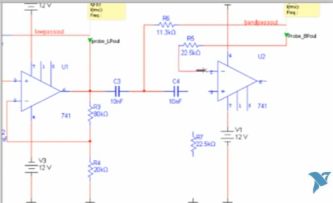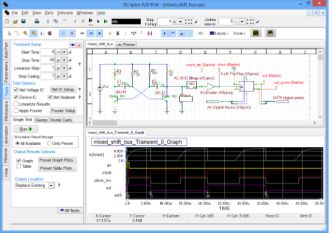If a semiconductor or vacuum tube is to accurately reproduce or amplify signals on its input, it must have on its input a non-time-varying dc voltage, i.e. dc bias, the purpose of which is to keep the device in its linear operating range. Otherwise, the input signal to be reproduced may drive the device beyond cutoff, or it may be insufficient to put the device fully into its linear region. In both cases, clipping of the reproduced signal will occur.
Biasing can take forms other than electrical. It can be magnetic, mechanical, hydraulic, pneumatic – wherever force is introduced into a system. Most often, this force is unchanging in amplitude and polarity. Besides being applied within an amplifier so it operates within a predetermined part of its transconductance curve, negative bias may be applied to a cathode so that electrons are launched and subsequently accelerated toward a CRT screen.
Biasing plays an important role in the operation of a diode and in transistors where any two terminals constitute a virtual diode. When negative bias is applied, electrons are repelled, gathering as charge carriers at the N-P or P-N junction. Positive bias pulls electrons away from the junction so that it cannot conduct.
Bias, in this case, high-frequency, is used in magnetic tape recording to improve audio quality by removing objectionable hiss.
These days, it’s often preferable to use a simulation program to determine circuit biasing for all but the simplest cases. Here are a few inexpensive and widely used programs that fit the bill.
PSPICE 9.1 Student Version from Orcad includes limited versions of PSpice A/D 9.1, Web Update 1, including PSpice Schematics 9.1 a choice of schematic editors, PSpice Schematics 9.1, Capture 9.1, and a part database from Digikey. There are also a number of tutorials available for the program:
https://www.uta.edu/ee/hw/pspice/ https://www.engr.colostate.edu/ECE562/Pspicetutorial.pdf https://cobweb.ecn.purdue.edu/~ee255/lecturesupp_files/PSpice-Tutorial.pdf https://www.ee.nmt.edu/~rison/ee321_fall02/Tutorial.html
OrCAD PSpice handles more than just bias calculations, of course. Its simulation provides dc, ac, and transient analysis. It also provides digital worst-case timing analysis to help find timing problems during signal transitions. Mixed-signal designs can also be verified where the analog portions have digital content embedded.
The program includes a library of component models and can determine whether a circuit is over-stressing specific components. It can also show you waveforms at nodes within the circuit. Included are interfaces to other simulation tools such as Matlab Simulink, and the program has an open architecture that allows customization of its features.
A similar program is OrCAD Lite. It offers every feature of OrCAD, limited only by the size and complexity of the design. There is no time limit for OrCAD Lite, you can use it as long as you want.

A screen-grab from the NI Multisim program.
NI Multisim is another SPICE simulation environment. From National Instruments, it integrates Spice simulation with interactive schematic entry facilities. There is a version specifically for education called Multisim for Education. The mainstream version is called Multisim for Designers. And there is a cloud-based version called Multisim Live.
The student edition of Multisim can be had for under $50 as of this writing. It provides such features as voltage, current, and power probes, export digital logic schematics in raw VHDL format, and export data to PCB layout programs.
The B2.Spice A/D circuit simulation package comes from EMAG Technologies Inc. in Ann Arbor, Mich. It has features that include visualizations that show actual current flow through the circuit and relative voltage relationships, an

A screen-grab from the B2.Spice program.
integrated parts library, parameterized subcircuit models, a circuit wizard that steps users through the creation of commonly used circuit diagrams, and device models that mimic real-world performance of passive components such as capacitors and inductors.
Students can get a copy of B2.Spice for a $10 monthly fee. You can purchase a one-seat license outright for under $600.
SuperSpice from AnaSoft Ltd. in the UK can be used in educational settings but claims to suffer none of the compromises that constrain such systems. Nevertheless, a full version can be had for the reasonable price of about $130 as of this writing, Simulation features include dc and ac analysis, display of circuit bias voltages an currents on the schematic, noise and distortion analysis, pole-zero and FFT capabilities, and a lot more.
Qucs stands for Quite Universal Circuit Simulator. Its creators say Qucs isn’t finished, but what is has going for it is the price: free. It is an integrated circuit simulator that gives the large-signal, small-signal and noise behavior of the circuit. After that simulation has finished you can view the simulation results on a presentation page or window. The software aims to support all kinds of circuit simulation types, e.g. DC, AC, S-parameter, Harmonic Balance analysis, noise analysis, etc. The simulation backend is a command line circuit simulator that takes a network list in a certain format as input and outputs a Qucs dataset. It has been programmed for usage in the Qucs project but may also be used by other applications.
TINA-TI is another freebee. It comes from Texas Instruments. TINA is a product of DesignSoft exclusively for Texas Instruments. This complimentary version is fully functional but does not support some other features available with the full version of TINA. It provides all the conventional dc, transient and frequency domain analysis of SPICE and much more. TINA has extensive post-processing capability for formatting results. Virtual instruments allow you to select input waveforms and probe circuit nodes voltages and waveforms.
There are numerous other circuit analysis programs available, but they tend to have more specialized features or are optimized for specific apps (such as those involving Arduino programming, for example.) A much more detailed summary can be found here: https://www.electronics-lab.com/downloads/circutedesignsimulation/?page=1







Leave a Reply
You must be logged in to post a comment.